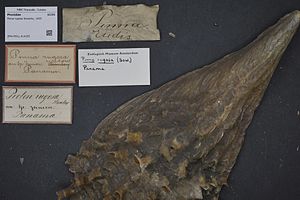Pinna rugosa
| Pinna rugosa | ||||||||||||
|---|---|---|---|---|---|---|---|---|---|---|---|---|

Pinna rugosa (from Panama) |
||||||||||||
| Systematics | ||||||||||||
|
||||||||||||
| Scientific name | ||||||||||||
| Pinna rugosa | ||||||||||||
| GB Sowerby I , 1835 |
The Pinna rugosa is a mussel species from the pen mussel family (Pinnidae). It occurs in the eastern Pacific from Baja California to Peru and in the waters around the Galapagos Islands .
features
The housing is elongated triangular and moderately swollen. It becomes up to 59 cm long. The dorsal and ventral edges are almost straight. The rear edge is arched. The inconspicuous, small vertebrae sit at the front tip of the case. The small elongated anterior sphincter sits in the foremost tip of the case. The elongated, significantly larger posterior sphincter is located just in the rear half of the housing, somewhat away from the rear end of the dorsal lobe of the mother-of-pearl layer . The ventral lobe is significantly shorter. The ventral and dorsal lobes are separated from one another by a very narrow sulcus that almost extends to the anterior sphincter muscle. The mother-of-pearl layer extends dorsally up to two thirds of the length of the case (seen from the front edge). The ligament extends over half of the dorsal margin.
The horn-brown shell is translucent, thin and fragile in juvenile cases. Older cases only have a slightly thicker shell, but are barely translucent and a little darker in color. There are 6 to 15 longitudinal ribs, usually six to eight. The number of ribs also depends on age. They multiply through the involvement of intermediate ribs. The ribs are covered with strong, open, tubular spines directed backwards. The spines are usually strongest at the rear end. In large and old specimens, however, the spines can be largely worn off.
Similar species
Pinna rugosa is the only Pinna species in its range and cannot be confused. The other pen shell species belong to the genus Atrina and Streptopinna , which differ particularly in outline.
Geographical distribution and habitat
The distribution area of the species extends in the eastern Pacific from Baja California (at 28 ° N), the Gulf of California (up to 31 ° N) over Panama to Peru (5 ° S) and to the waters around the Galapagos Islands .
The species lives on sandy soils between rocks and gravel from the tidal range to about 100 meters water depth.
Pinna rugosa is segregated, but with a high proportion of hermaphroditic individuals (around 20%). In the Gulf of California, the species reproduces from May to November, depending on the water temperature. Occasionally the shrimp Pontonia simplex Holthuis, 1951 and the small intestinal fish Encheliophis dubius (Putnam, 1874) live as commensals in the mantle cavity .
Economical meaning
The species is intensively fished in the Gulf of California. Mainly the large posterior sphincter, but also the smaller anterior sphincter and occasionally the mantle, are eaten. Decorative cases are sold as jewelry and keepsakes.
Taxonomy
The species was established by George Brettingham Sowerby I in 1835 . MolluscaBase accepts Pinna rugosa as a valid species.
literature
- Eugene V. Coan, Paul Valentich-Scott: Bivalve Seashells of Tropical West America marine Bivalve mollusks from Baja california to Northern Perú. Part 1,598 pp., Santa Barbara Museum of Natural History, Santa Barbara 2012 ISBN 978-0-936494-43-2 (p. 228)
- Peter Schultz, Markus Huber: Revision of the worldwide Recent Pinnidae and some remarks on fossil European Pinnidae. Acta Conchyliorum, 13: 164 S., Hackenheim, ConchBooks, 2013 PDF (summary)
Individual evidence
- Jump up ↑ Bertha Patricia Ceballos-Vázquez, Marcial Arellano-Martínez, Federico García-Domínguez, Marcial Villalejo-Fuerte: Reproductive cycle of the rugose pen shell, Pinna rugosa Sowerby, 1835 (Mollusca). Journal of shellfish research, 19 (1): 95-99, 2000 online at www.biodiversitylibrary.org
- ↑ Eduardo Balart: Corroboration of the bivalve, Pinna rugosa, as a host of the Pacific pearlfish, Encheliophis dubius (Ophidiiformes: Carapidae), in the Gulf of California, México. Copeia, 199 (2): 521-522, 1999.
- ↑ Rick Harbo: Harvesting Wrinkled Pen Shells ("scallops"), Pinna rugosa, in Baja California, Mexico. The Dredgings, 50 (4): 5, 2010 PDF
- ↑ George Brettingham Sowerby I: Characters and observations on new genera and species of Mollusca and Conchifera collected by Mr. Cuming. Gender Pinna. Proceedings of the Zoological Society of London, 3: 84-85, London 1835 Online at www.biodiversitylibrary.org
- ^ MolluscaBase: Pinna rugosa GB Sowerby I, 1835
Web links
- Encyclopedia of Life: Pinna rugosa GB Sowerby I, 1835
- Galapagos Species Checklist: Pinna rugosa ( Memento from May 18, 2016 in the Internet Archive )